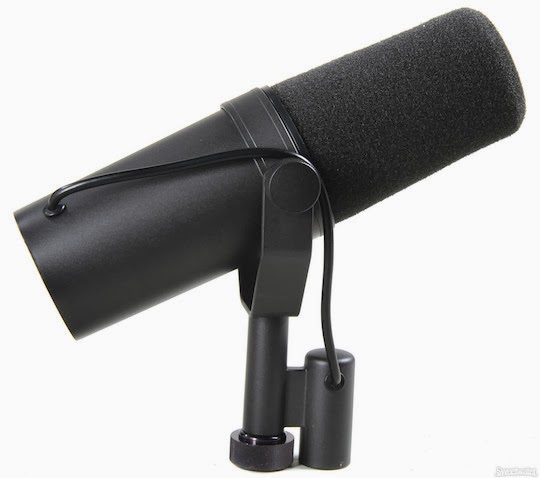It’s time for another top 10 list, and this time we’ll be looking at the mics I use. Now once again keep in mind that I’ve excluded lots of great microphones only because I don’t have frequent access to them. Mics are such a personal choice because it has to do with how your ear matches up to what the mic is capturing. That said, here’s what I find myself using over and over when I record if they’re available, but you could ask me again next week and the order might be different and some models would be replaced with something else.
1. Neumann U87: I’ve had a love/hate relationship with the 87 over the years, but I have to say that it’s back on the love side of things. Without getting into splitting hairs on the models, I know what I’m going to get and the sound is always up to the high standard that I expect from the model. I love using it on toms, percussion, guitar and bass amps and vocals (especially in omni).
 |
| Royer R-121 |
2. Royer R-121: What a wonderful mic! It sounds great on most anything, takes EQ incredibly well, and is as rugged as a ribbon mic can get. I’ll use it on electric and acoustic guitars, overheads, percussion from a distance, and even on vocals occasionally.
3. AKG C414: Once again, you can split hairs over the models (there’s no doubt that the older versions sound better), but I know what to expect from the mic and it generally does not disappoint. I’ll use this most anywhere I’d use an 87 where the sound might need a bit more edge.
4. Neumann KM84: This is one of the best small diaphragm mics ever, in my opinion. I’ll use a 184 if I can’t get the real thing, but once again, it’s not the same. I love it on the snare, hat and acoustic guitars.
 |
| Shure SM-7B |
5. Shure SM-7B: One of the most overlooked mics ever, it’s really an SM 57 on steroids with a much bigger and bolder sound. This is a great vocal mic, especially for singers with an edge to their voice. It’s also a great mic for voice-overs, which I do a lot of.
6. Electro-Voice RE-20: This is one of my favorite kick drum mics. There’s no hype involved, just a nice big bottom if the drum has it in the first place. It also makes a great vocal mic on some singers.
7. Shure Beta 57: While many engineers swear by the regular old SM57 for guitars and snare, I like the newer Beta 57 better. It has a tighter pickup pattern so the isolation is better, and it’s a little crisper. I’ll use it on snare, guitar amps (along with a R-121), and hand drum percussion. I do prefer the older Beta 57 to the new 57A a little, but they’re much harder to find these days.
 |
| Mojave MA-200 |
8. Mojave MA-200: David Royer is a smart fellow and his tech knowledge extends beyond ribbon microphones, as his Mojave condenser mics testify. The MA-200 is a multi-pattern large diaphragm condenser that can be used anywhere I’d normally use a U87. I’d have to say that it’s a bit smoother sounding, although sometimes that’s not what you want. I’ve used it on acoustic guitars, strings, and percussion. I’d love to try it on toms, but there’s usually never enough of them around for an entire kit.
9. AKG C12: I have this down lower on my list not because it’s not a favorite mic, but because you can’t always find one. I love it on vocals, it’s magic on overheads and with strings, and it’s great on a bass amp (thanks Ken Scott, who uttered the words seared into my brain – “This is what I used to use on Paul.”).
 |
| ADK 3 Zigma C-LOL-12 |
10. ADK 3 Zigma C-LOL-12: That’s a mouthful of a model, but it’s basically an AKG C12 emulation and it’s a really good one. I like it on toms and bass. It’s very impressive for the price.
Once again, you might find some of the choices unusual. I’m not trying to say that other mics don’t deserve to be on a top 10 list somewhere, but these are the ones I find myself reaching for if they’re available.
What mics are on your list?


